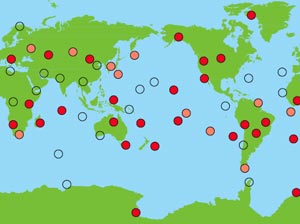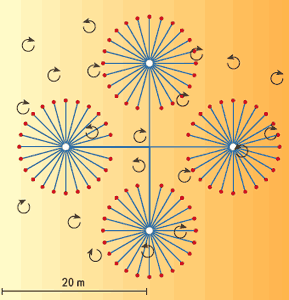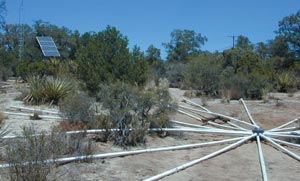From listening in on volcanoes to detecting nuclear explosions, a global network of infrasound detectors is allowing researchers to tune in to our atmosphere, explain Michael Hedlin and Barbara Romanowicz
Our atmosphere is filled with sounds that we cannot hear. The Earth hums; volcanoes howl, pop and whistle; storms roar menacingly; and meteors scream before exploding high above the ground. We are oblivious to this perpetual symphony because it takes place at frequencies below the lower limit of human hearing, otherwise known as infrasound.
The human ear is sensitive to sounds with frequencies between about 20 and 20,000 Hz. These mid-range waves lose energy rapidly, which means we can only hear sounds coming from our immediate surroundings. But sounds exist both above and below the audible range - ultrasound, for example, can have frequencies of several megahertz. Ultrasound decays very quickly and cannot be detected very far from its source, which makes it useful for biological imaging. But with frequencies as low as a few millihertz, infrasound can travel distances of several thousand kilometres.
It was the eruption of the Indonesian volcano Krakatoa in 1883 that showed scientists that what we can hear is just a narrow slice of the full acoustic spectrum. This eruption generated the loudest recorded sound in history, and was distinctly heard some 4800 km away on the island of Mauritius. However, had barometers - which are sensitive to very gradual changes in air pressure - not recorded the cataclysmic event, most of the rest of the world would only have found out about it by word of mouth.

A global network of barometers is now allowing researchers to tune into the unheard world of infrasound in great detail. Similar to the way that radio waves have extended our vision of the universe at lower wavelengths, infrasound allows us to explore the acoustic properties of the atmosphere in a new way. As well as allow us to eavesdrop on a storm or a meteor exploding 1000 km away, or perhaps a large volcanic eruption on the other side of the planet, researchers hope that the Global Infrasound Network will advance our understanding of the Earth's atmosphere and interior (figure 1). Furthermore, it will significantly improve our ability to monitor for tests of nuclear weapons.
The subsonic world
Sound can be described simply as the vibration of a material. Atmospheric sound, for instance, is the rhythmic back and forth movement of air. Although a source of sound might initially disturb only a small volume of air, once set in motion that air will continue to oscillate like a spring until the energy of motion is lost. As a general rule, the smaller the volume of air initially disturbed, the higher the frequency of the sound produced. So in order to produce infrasound, a source must be able to move a large volume of air.
Some large mammals, such as elephants, rhinoceros and whales, are known to use infrasound at frequencies just below 20 Hz to communicate with each other over distances of many kilometres. Man-made infrasound at frequencies between about 0.1 and 10 Hz is also produced by large chemical or nuclear explosions, rockets and supersonic aircraft. But the main source of infrasound is the Earth itself, which generates acoustic waves at much lower frequencies from volcanic eruptions, tornadoes, avalanches, earthquakes, meteors, aurora, storms and atmospheric turbulence. Infrasound also comes directly from the Earth's solid interior, producing a constant vibration or "hum" with a frequency of just a few millihertz (see "The mystery of the Earth's low-frequency hum").
It is possible to physically feel intense infrasound at frequencies above about 1 Hz, for example by standing at the foot of a runway when a large jet aircraft flies overhead. Infrasound can also induce a sense of uneasiness - in 2003, for instance, UK researchers found that they could induce sadness and anxiety in an audience by pumping acoustic waves with a frequency of 17 Hz into a concert hall.
Dynamic atmosphere
To make sense of the infrasonic world, we need to know precisely how infrasound propagates through the atmosphere. As sound is a mechanical wave, it is similar to the compressional seismic waves that travel through the Earth's interior. But the way infrasonic waves propagate differs significantly from seismic waves due to the rapidly changing "velocity structure" of the atmosphere. As with any other wave phenomenon, infrasound changes direction or refracts due to changes in the velocity of the medium it passes through. (This explains why ultrasound can produce such sharp images of inside the body.)
In the atmosphere the velocity of infrasound is directly proportional to the square root of the absolute temperature of the air, and it is also affected by the direction of the wind. However, both the temperature and wind direction also depend on altitude, geographic location, time of day and time of year, which complicates things considerably. For instance, infrasound refracts back to the Earth's surface from within both the stratosphere (which exists at an altitude of 20-50 km) and the thermosphere (altitudes above 85 km) due to the increase in temperature with increasing altitude in these layers. In the lowest 10 km of the atmosphere (the troposphere) the temperature decreases with increasing altitude - but infrasound can still be refracted back to the ground from this layer due to strong winds.
In order to study infrasonic phenomena remotely we need to take into account this dynamic structure of the atmosphere. In 2000 geophysicist Doug Drob at the Naval Research Laboratory in the US developed a way to do this based on numerical weather-prediction models and measurements from balloon-borne experiments. His models are proving to be particularly useful for determining how infrasound propagates, as they incorporate changes in atmospheric structure over time at small spatial scales. Previously we had to rely on long-term averages of atmospheric conditions for this purpose, and the models did not include regional scale variations in atmospheric properties.
Detecting infrasound is most commonly done using "aneroid microbarometers", which consist of an evacuated chamber that deforms under slight changes in the external air pressure. The devices are calibrated so that these deformations can be converted electronically to show these changes in the external air pressure in the form of a spectrum. However, our ability to detect infrasound waves with such instruments is limited by noise due to atmospheric turbulence.

Most noise in the frequency band of interest to the infrasound community - about 0.01-10 Hz - is essentially unchanged or "coherent" over distances less than several metres, while infrasonic signals can be coherent over distances greater than 100 m. The ratio of signal to noise can therefore be increased by ensuring that infrasound is sampled via sound inlets distributed over an area tens of metres across. The signals from each inlet are then combined in a microbarometer via an array of pipes to determine the average change in the local air pressure (figure 2).
Although we have known of infrasound since the late 1800s, the modern era of infrasound began with the advent of the nuclear age. This is because atmospheric explosions of nuclear weapons generate infrasonic waves with large amplitudes, offering a way to monitor nuclear proliferation. This interest increased in 1996 when the Comprehensive Nuclear Test Ban Treaty, which banned all nuclear tests, was introduced. In particular, the treaty called for a global network of sensors to continuously monitor the atmosphere for infrasonic signals from atmospheric explosions, in addition to the seismic and hydro-acoustic networks that were already in place to monitor blasts in the Earth's interior and oceans.
Today, over half of this network - which is designed to provide uniform coverage of the Earth's atmosphere using 60 infrasound stations optimized for frequencies between 0.1 and 1.0 Hz - is complete. Each station in the Global Infrasound Network will comprise between four and eight microbarometers equipped with a noise-reducing filter, which will provide an infrasonic aperture of between 1 and 3 km. The use of arrays of sensors, rather than single instruments, allows more faint infrasound signals to be detected and provides an estimate of the speed and direction of the incident waves.
As well as monitoring for nuclear tests, the infrasound network is proving extremely useful for basic research into natural phenomena - many of which pose serious hazards. On 30 June 1908, for example, an explosion over the Tunguska region of Siberia registered on barometers in the UK several thousand kilometres away. Although scientists still debate the exact cause of the event - which scorched and felled trees in an area about the size of Washington, DC - there is agreement that it was due to the explosion of a comet or a meteor several kilometres above the Earth's surface. Tunguska was a blistering example of how the Earth's surface can be devastated locally by a large explosion above ground, and of the importance of infrasound in providing evidence for such events. The Global Infrasound Network will allow researchers to study, among other things, how often these large explosions occur, in order to get a better estimate of the threat they pose.

Indeed, numerous large meteors have been recorded recently by infrasound stations. In 2001, for example, a meteor exploded 30 km above the Pacific between infrasound stations in California and Hawaii (figure 3). Researchers in the US, Europe and Australia were able to use data from these and other stations to pin down the location of the explosion and, combined with knowledge of atmospheric conditions, estimate its size. However, in general such estimates are still quite uncertain.
Infrasound can also be used for monitoring volcanoes, both for basic research and for hazard mitigation. It is well known that volcanoes can be monitored by seismometers, since movements within and beneath the volcano produce elastic waves within the Earth. More recently we have discovered that volcanoes radiate energy in all directions, including upwards into the atmosphere. Although we have monitored volcanoes for centuries to safeguard people living nearby, the fact that volcanoes erupt material upwards poses a serious threat to passing aircraft. This threat can be difficult to either assess or predict, since not all volcanic-ash releases are marked by clear seismic activity and not all erupted material can be tracked via satellites. As eruptions are inherently acoustic in nature, however, infrasound monitoring might complement existing volcano-monitoring technologies.
In addition to monitoring volcanoes for ash releases, or developing better statistics on meteor impacts, infrasound can be used to track storms as they circulate and generate low-frequency infrasound waves. An area of particular interest is how to establish the acoustic signature of storms over the Atlantic ocean while they are in the earliest stages of formation. This may provide an early-warning system for tropical storms or hurricanes before they hit land, although it remains to be seen how useful infrasound is in this regard.
Light work
There is still room for improvement in the design of infrasonic detectors, in particular to make them more sensitive to faint signals. In the last few years, a group at the University of California in San Diego led by Mark Zumberge and Jon Berger has developed a new detection system based on optical fibres. The "optical fibre infrasound sensor" or OFIS consists of a flexible tube surrounded by fibre-optic cables that measure the changes in the tube's diameter as it expands and contracts with varying external pressure from infrasound waves. Two types of fibre-optic cable are used: one is relatively strong and insensitive to the flexing of the tube, while the other has a greater sensitivity to such variations. Using interferometry, differences in the strain in the two cables can be measured precisely and then converted into average variations in atmospheric pressure along the entire length of the flexible tube.
The OFIS gets round some of the drawbacks of reducing noise mechanically using filters because it does not require sound waves to travel through a system of pipes. Instead, changes in air pressure due to atmospheric turbulence that are much smaller than the length of the tube are averaged away, reducing the level of noise in the recording and allowing the sensors to detect faint signals. Furthermore, the sensitivity to infrasound of each OFIS tube depends on the angle at which the signal travels across it, which means that several tubes oriented in different directions can provide information about the direction of the infrasonic source.
Another novel infrasound detection system currently being developed by researchers at the University of Mississippi and the Southern Methodist University in the US is the "distributed sensor". Comprising a grid of sensors that each sample the infrasonic pressure field independently, this system is able to both reduce noise and provide directional information about an infrasonic source by optimally integrating the signals from all the sensors electronically. Although this is the same principle used in a standard microbarometer array, the distributed sensor is much smaller and therefore offers the potential for cramming a larger number of elements into a smaller area.
Seismic shift
As the Global Infrasound Network nears completion in the next few years, the challenge now is to learn how to best exploit this huge asset. In monitoring the atmosphere continuously, the network offers an unprecedented opportunity to improve our understanding of both man-made and natural atmospheric phenomena on a global scale. Key issues to be addressed are how sound propagates through our unsteady atmosphere, and how clear measurements of distant events can be made despite noise due to atmospheric turbulence. Our expertise increases with each new source of infrasound we discover, whether it be huge electrical discharges in the upper atmosphere known as sprites, turbulence from air flowing over a mountain range or continuous noise from the oceans.
Several decades ago the seismic community was struggling with similar issues when it developed the first global seismic network. These included how to manage the large volume of data produced and how to extract the best information about the structure of the Earth and the physics of seismic sources. Although there was much excitement about the potential uses of the new network, researchers could hardly have imagined the enormous progress made in our understanding of the inner workings of our planet such as earthquakes since the first data became available.
Those of us in the infrasound community see a clear parallel with our new network. There is a palpable excitement about what we will learn about the Earth's outermost shell - the atmosphere - using the new infrasound network. In two or three decades we will surely look back at these years and reflect on how little we imagined we could do with the data. Just as the global seismic network has been used for fundamental research and hazard reduction, we expect the infrasound network to provide a similar insight into how our atmosphere works.
The mystery of the Earth's low-frequency hum
The atmosphere is awash with infrasonic noise from turbulence, storms and aurora at frequencies ranging from about 0.01-10 Hz. But about 10 years ago researchers discovered another type of persistent noise at even lower frequencies of 3-7 mHz. This noise, which was picked up by seismometers in the global seismic network, is now known as the Earth's "hum" - and its origin has been the subject of heated debate.
The seismometers used to detect the hum were designed for studying the elastic waves produced by large earthquakes deep in the Earth's interior, and are particularly sensitive to vibrations between 0.3 and 10 mHz. When an earthquake with a magnitude of about 6.5 or more on the Richter scale takes place, the entire planet vibrates at frequencies that depend on its shape and internal composition - much like a bell rings with a distinctive pitch. These vibrations, which are called the Earth's normal modes, decay with time because the planet is not a perfectly elastic body. In 1988 however, based on 10 years' of data, Japanese researchers found that the modes were also present during "quiet" periods when there were no significant earthquakes.
The source of this low-frequency hum intrigued many seismologists. It was initially thought to be generated by the combined effect of very small earthquakes that occur all the time around the world. But this possibility was soon ruled out because the source of the hum had to be much nearer the Earth's surface to explain the particular fundamental modes that were being observed. Furthermore, the amplitude of the hum varied seasonally, making it unlikely that it had anything at all to do with tectonic plates.
Then in 1999 researchers turned their attentions back to the atmosphere, hypothesizing that the hum was due to atmospheric turbulence pounding incessantly on the Earth's surface. In an attempt to investigate this possibility, in 2003 one of the present authors (BR) turned to "array analysis" in order to discriminate between sources that were distributed around the world and those that were more localized, both in time and in space. It so happens that there are two large regional arrays of seismometers deployed at just the right scale for such an analysis: one in the US operated by the Berkeley Seismological Laboratory and the other in Japan.
By pointing these arrays in different directions, and by summing the resulting seismic traces so as to enhance the signal coming from elastic "Rayleigh" waves, in 2004 we found that the strongest hum signal came from the oceans. Moreover, it came predominantly from the North Pacific during the northern-hemisphere winter and from the southern Atlantic and Pacific during the northern-hemisphere summer, following seasonal fluctuations in wave height as measured by satellite telemetry. Earlier this year we were able to identify particularly strong individual hum events and relate them to specific storms propagating across the North Pacific and hitting the western coast of North America.
An interesting aspect of our analysis, however, was that we were able to show that the origin of the hum was similar to that of the much stronger "micro-seismic noise". This signal is present in all seismic measurements at frequencies between 0.1 and 1 Hz, and has long been known to come from non-linear interactions between ocean waves near the coast. The Earth's hum is now thought to be generated in the oceans by a cascade of processes, which begins with the generation of ocean waves (typically with a period of 0.1 Hz) that are then converted into longer-period "infra-gravity" waves via storm activity. Because ocean storms travel predominantly from west to east, this conversion occurs primarily near the east coast of ocean basins. The long infra-gravity waves then propagate in all directions, interacting with the complex topography of the seafloor near coasts around the ocean basins to generate the elastic waves of the Earth's hum. Although faint, the ubiquitous nature of the hum provides hope that it can be used in conjunction with earthquake signals to study the structure of the Earth's upper mantle.
At a Glance: Infrasound
- Unlike audible sound, infrasound can travel thousands of kilometres through the atmosphere and is used by some animals as a form of communication
- The main sources of infrasound are geophysical, such as earthquakes and volcanoes, but nuclear explosions also produce large infrasonic waves
- Infrasound can be detected using barometers that are sensitive changes in air pressure, but such measurements are challenging to make due to atmospheric turbulence
- A global network of infrasound sensors is currently being assembled that will allow the atmosphere to be studied in unprecedented detail, and possibly reduce the risk posed by certain natural hazards
A Bedard and T Georges 2000 Atmospheric infrasound Physics Today March pp32-37
M Hedlin et al. 2002 Listening to the secret sounds of Earth's atmosphere EOS 83 564-565
Inframatics organization: www.inframatics.org
University of Hawaii Infrasound Laboratory: www.isla.hawaii.edu





Reader Comments
to our Newsletter